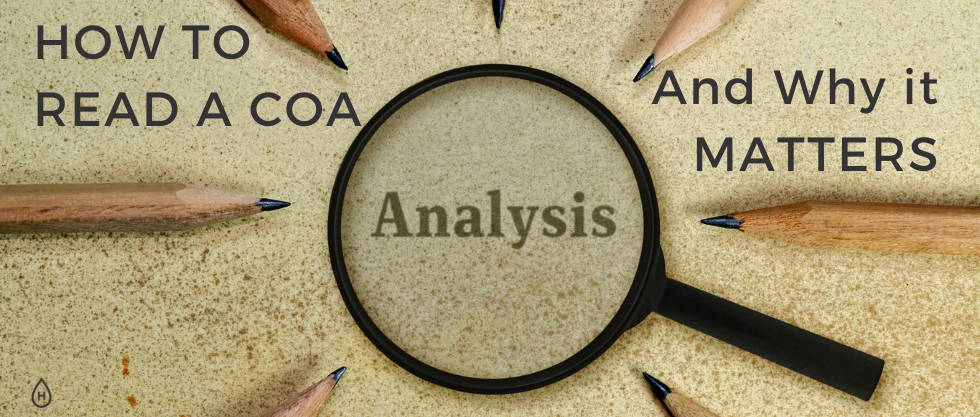You deserve transparency from every brand you encounter. As a brand, we want you to know our product inside and out so you can feel confident consuming it. A COA, or certificate of analysis, is a document that outlines all the tests that testers must perform on a product before it hits the shelves for customer purchases.
COAs exist because chemical manufacturers have to prove that their products meet all of the requested specifications, pass quality assurance and safety tests, and consist of precisely what they advertise.
The COA exists so that a customer can report to a regulatory body such as the International Organization for Standardization (ISO), Food and Drug Administration (FDA), or the Occupational Safety and Health Administration (OSHA).
Knowing what you are buying is extremely important, especially something entering your body. If a COA is new to you, it’s best to learn how to read one to feel safer in your shopping experience.
Let’s take a few minutes to learn how to identify and read a COA to be ahead of the game when choosing what is safe and suitable for you.
How to Read a COA: Step-by-Step
1. Find the COA
It’s a red flag if a site doesn’t have lab reports on each product. There are lab reports attached to every product on our website. For example, our delta 8 gummies show off the batch lab report in its photos. We wanted to make it as easy as possible to see the lab results of our products.
Unfortunately, not all companies make it as evident or as easy to access, so always check their online resources for the best way to find their COA.
2. Read the Product Label
Whether you find the COA first or go over the details on the label instead, what’s important is to see what the package claims are inside.
Most customer-facing packaging will openly make claims about testing or content percentages, but that does not equal the actual test results. The reason you want to look over the product label carefully is to have a list of claims to measure against the COA.
3. Know What to Look for
When reviewing a COA, there are several key things to look for:
Product name and identification
Make sure that the product listed on the COA matches the product you’re considering purchasing.
Test results
The COA should include the results of various tests that have been performed on the product. These can include tests for potency, purity, and contaminants.
Specification limits
Next, the COA should specify the acceptable limits for each test. The actual test results should fall within these limits.
Testing methods
Then, the COA should include information about the methods used to perform the tests, including any relevant standards or guidelines that were followed.
Batch or lot number
Lastly, the COA should include the batch or lot number of the product being tested, which allows you to track the product back to the specific batch it came from.
Date of testing
It’s important to know when the product was tested, as the quality of the product may change over time.
Issuing authority
The COA should include information about the issuing authority, such as the name of the laboratory or company that performed the tests.
By reviewing the COA, you can better understand the quality and purity of the product you are considering purchasing. It is essential to ensure that the product meets all relevant specifications and standards and has been tested by a reputable laboratory or manufacturer.
Where to Find a COA
Some other manufacturers may include a QR code to make it possible to track the batch COA that way. Others may require you to go to their website and use the lot number found to look for the COA.
Whichever method a company uses, the most crucial part is that they provide access. If a company avoids sharing these critical papers or has excuses why they can’t, it’s safe to assume they may be cutting corners and not ensuring the safety of their products.
If the COA is not clearly labeled, make sure to ask the manufacturer about them to double-check.
The Inaccuracy of Most Labels on the Market
Consumer product labels can often be misleading in several ways. Some common examples include:
- False or exaggerated claims: Some labels make false or exaggerated claims about the benefits or features of the product. For example, a label may claim that a product is all-natural when it contains synthetic ingredients. Or it may claim that a product is clinically proven to do something without providing any scientific evidence to back up the claim.
- Misleading language: Some labels use ambiguous or vague language to mislead consumers about the contents or effectiveness of the product. For example, a label may use the term “fragrance” to hide potentially harmful chemicals used to give the product a pleasant smell.
- Misleading sizing or quantity: Some labels may use misleading sizing or quantity information to make the product seem more valuable or appealing to consumers. For example, a label may use large font sizes to emphasize the product size while hiding important information about the actual amount of product contained within.
- Misleading certifications or endorsements: Some labels may use fake or misleading certifications or endorsements to give the impression that the product is of high quality or has been endorsed by a reputable organization.
Overall, misleading consumer product labels can harm consumers, as they may lead people to purchase products that are not as effective or safe as they believe. It is vital for consumers to be aware of these tactics and to carefully read labels before making a purchase.
This is why a verifiable COA is so important in today’s market. Thanks to the wide availability of testing information, it has become much easier to check the actual results of a product to ensure that you are buying something that will be helpful instead of dangerous.
 Top Red Flags to Watch Out for When You Read a COA
Top Red Flags to Watch Out for When You Read a COA
Just because a company has a COA doesn’t mean it is automatically accurate or honest. When reading a COA, you should keep your eyes open for a few warning signs.
Some things that stand out as a red flag include:
- If things like CBD content on the label does not match the COA
- Labels for things such as “Broad Spectrum” that lack any other phytocannabinoids on the COA
- If THC in the COA is above 0.3%
When the product label information fails to match up with the COA, corners are being cut in the production line.
COAs for anything in the cannabis industry are essential. The industry is still new and growing. Due to a lack of FDA oversight, companies must hold themselves accountable in the public eye.
Anyone fudging the numbers or not releasing verifiable COAs should be called into question for the safety of the consumer.
Final Thoughts
In conclusion, COAs are important in trusting a product and its contents. In both the cannabis world and even when it comes to our fish poop, COAs are essential and necessary.
Now that you have a fuller understanding, you can make a more informed decision about what’s in your products. Furthermore, you can now decide which brand you trust the most based on their lab reports.
